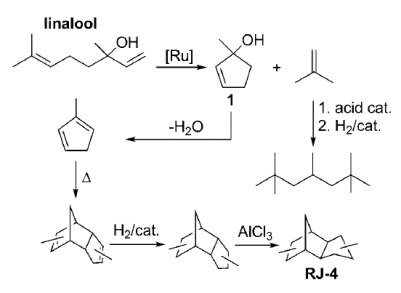Fuels for jet and missile propulsion require molecules with more defined and specialized properties than those for general transportation fuels. The challenge of producing these on an industrial scale from renewable resources has been hindered by the modest turnover numbers and high costs of the catalysts involved.
Benjamin Harvey and colleagues, Chemistry Division, US Navy, have reported a ruthenium-catalyzed synthesis of 1-methylcyclopent-2-enol from linalool, a linear terpene alcohol derived from waste cellulose. 1-Methylcyclopent-2-enol and isobutylene, the side product, can be converted to the high-density missile fuel RJ-4 and jet fuel, respectively.
The team used a second generation Grubbs–Hoveyda catalyst at room temperature under solvent-free conditions. This produced 1-methylcyclopent-2-enol in 100 % yield in 45 min.

Image: (c) WIley-VCH
- Solvent-Free Conversion of Linalool to Methylcyclopentadiene Dimers: A Route To Renewable High-Density Fuels
H. A. Meylemans, R. L. Quintana, B. R. Goldsmith, B. G. Harvey
ChemSusChem 2011.
DOI: 10.1002/cssc.201100017



